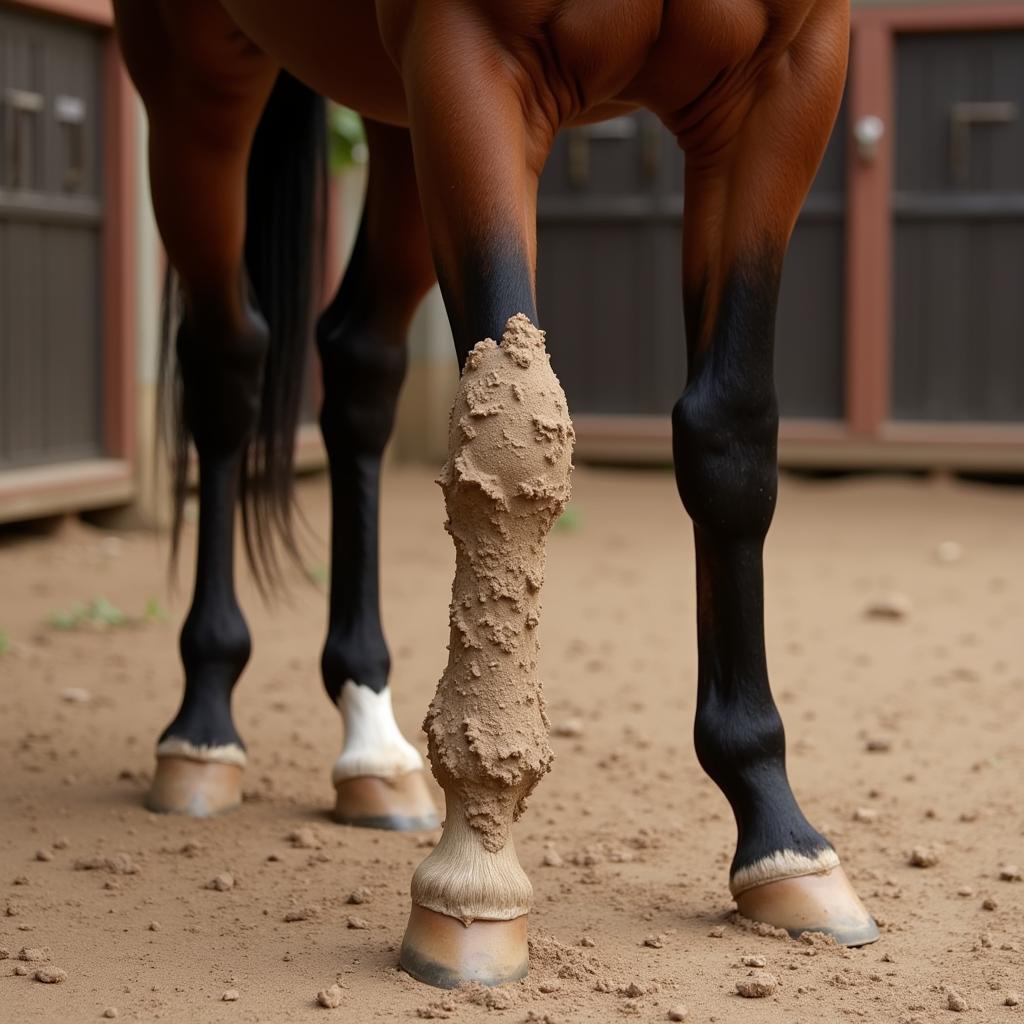Indian mud, also known as Multani mitti or Fuller’s earth, has been used for centuries in various cultures for its purported benefits on skin and hair. Its use has extended to animals, including horses, where some believe it offers similar advantages. But what exactly is Indian mud, and is it safe and effective for your equine companion?
What is Indian Mud and How Does it Work?
Indian mud is a type of clay rich in minerals like magnesium, silica, and calcium. It has absorbent properties, meaning it can draw out impurities, excess oils, and toxins. Some horse owners believe applying Indian mud as a poultice can help soothe minor skin irritations, reduce swelling, and even draw out infections. However, it’s crucial to understand the scientific evidence (or lack thereof) behind these claims.  Applying an Indian Mud Poultice to a Horse
Applying an Indian Mud Poultice to a Horse
The Benefits and Risks of Using Indian Mud on Horses
While anecdotal evidence suggests potential benefits, scientific research on the efficacy of Indian Mud For Horses is limited. Some horse owners report positive results using it for:
- Soothing minor skin irritations: The clay’s absorbent nature might help dry out weepy or itchy skin.
- Reducing swelling: The cooling effect of the mud could potentially offer temporary relief from swelling.
- Drawing out infections: While the clay might absorb some surface debris, it’s unlikely to penetrate deep enough to effectively treat infections. dhokra horse
It’s important to note that using Indian mud on horses also carries potential risks:
- Drying out the skin: Overuse can lead to excessively dry and irritated skin, exacerbating existing problems.
- Interfering with wound healing: Applying mud to open wounds can create a barrier that prevents proper airflow and hinders the healing process.
- Allergic reactions: Some horses might be sensitive to the components of Indian mud, leading to allergic reactions.
“While Indian mud can seem like a natural remedy, it’s essential to remember that ‘natural’ doesn’t automatically mean ‘safe’,” says Dr. Emily Carter, DVM, specializing in equine dermatology. “Always consult with your veterinarian before using any new treatments on your horse, especially on open wounds or sensitive areas.”
How to Use Indian Mud for Horses (If Recommended by Your Veterinarian)
If your veterinarian approves the use of Indian mud for your horse, follow these guidelines:
- Choose high-quality Indian mud: Opt for pure, unadulterated Multani mitti or Fuller’s earth from a reputable source.
- Prepare the poultice: Mix the clay with water to create a thick paste.
- Apply the poultice: Spread a thin layer of the paste over the affected area, avoiding open wounds.
- Allow the mud to dry: Leave the poultice on for 20-30 minutes, or as directed by your veterinarian.
- Rinse thoroughly: Remove the dried mud with lukewarm water, ensuring no residue remains.
- Monitor for any adverse reactions: Watch for signs of irritation, swelling, or discomfort.
“Remember, less is more,” advises Dr. Carter. “Start with a small test area to check for any reactions before applying the mud to a larger area. And never use Indian mud as a replacement for proper veterinary care.” things needed for a horse
Conclusion
Indian mud for horses might have some potential benefits for minor skin issues, but scientific evidence is lacking. Always consult with your veterinarian before using it on your horse. Proper diagnosis and treatment are crucial for ensuring your horse’s health and well-being. Remember, Indian mud should never be used as a substitute for professional veterinary care.
FAQ
- Is Indian mud safe for all horses? No, some horses may have allergic reactions. Always consult your vet.
- Can Indian mud treat infections? It might absorb surface debris, but it won’t cure infections.
- How often can I use Indian mud on my horse? Follow your veterinarian’s recommendations.
- Where can I buy Indian mud for horses? Look for pure Multani mitti or Fuller’s earth from reputable sources.
- What should I do if my horse has a reaction to Indian mud? Rinse the area immediately and contact your veterinarian.
- Can I use Indian mud on open wounds? No, it can hinder healing.
- Is Indian mud a substitute for veterinary care? Absolutely not.
Common Scenarios & Questions:
- Scenario: Your horse has a minor scrape on its leg. Should you use Indian mud? Consult your vet first. They might recommend other treatments.
- Question: My horse has sensitive skin. Is Indian mud a good option? It might irritate sensitive skin. Talk to your vet before trying it.
Further Reading
Explore our other articles on horse care and health on Justus Horses USA.
Need help? Contact us: Phone: 0772127271, Email: [email protected] or visit us at QGM2+WX2, Vị Trung, Vị Thuỷ, Hậu Giang, Việt Nam. We offer 24/7 customer support.